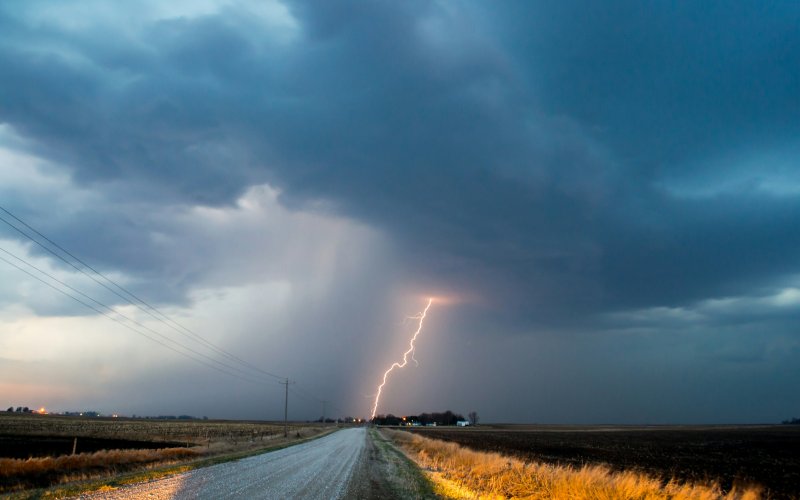UAlbany Study: Joint Effects of Thunderstorms and Power Outages Increase Respiratory-Related Emergency Department Visits

By Erin Frick
ALBANY, N.Y. (July 30, 2024)—Thunderstorms are among the severe weather events increasing in intensity and frequency due to climate change, with direct impacts on public health.
The trend is a particular concern in New York State, where more than 30% of all severe weather events in the last 20 years were thunderstorms. People with respiratory disorders are especially at risk, due to thunderstorm-related asthma and power outages that can disrupt critical breathing-assistance devices like ventilators, oxygen supply systems and nebulizers.
A new study led by researchers at the University at Albany is among the first to examine the joint effects of thunderstorms and power outages on respiratory-related emergency department visits in New York. While both storms and outages are known to have health effects, few studies have examined these impacts together.
The work was recently published in Environmental Health Perspectives.
“We know that thunderstorms and power outages may have health implications based on prior research,” said lead author Shao Lin, professor of environmental health sciences at the School of Public Health. “However, very few studies have looked at their joint impacts on respiratory diseases and especially the severe effects resulting in emergency department visits. Because we know that thunderstorms are increasing with climate change, it is critical to connect the dots between severe storms, power outages and the severe respiratory cases that medical facilities can expect to receive when they coincide.”
Connecting Thunderstorms, Power Outages and Health
Beyond direct effects on life-sustaining breathing devices, power outages can have cascading effects on health outcomes. Lack of power to water towers, refrigerators and sewage treatment plants can impact the quality of drinking water and food, and contribute to comorbidities like water and food-borne diseases. The use of generators during power outages can also deteriorate indoor air quality. Plus, the co-occurrence of thunderstorms and power outages can cause physical and psychological stress—especially among populations with limited access to medical resources, transportation or communication lines. Stress and anxiety are known to exacerbate respiratory conditions.
Developing targeted interventions to preempt severe respiratory episodes requires a close understanding of the environmental and demographic factors that influence risk.
“Thunderstorms are widely recognized for their capacity to trigger large-scale allergic respiratory infections by causing suspended pollen particles to fragment into smaller particles that are easier to inhale,” said Quan Qi, a PhD student of the Department of Economics who has been working with Lin for over two years. “Thunderstorms can cause rapid changes in temperature, relative humidity and air pollutant levels, all of which have been shown to adversely affect respiratory health. Further, lightning can positively charge airborne allergens, increasing the likelihood of these particles settling in the lungs. All of these factors combined can increase the risk of respiratory disease infections and exacerbations, resulting in increased emergency department visits during or after thunderstorms.”
To explore the connection, the research team brought together data on weather and air pollution, alongside demographic information collected from respiratory patients who visited emergency departments in New York from 2005-2018. Demographic information included gender, race, ethnicity, age, insurance type and the respiratory health condition (e.g. asthma, chronic obstructive pulmonary disease, bronchitis, respiratory infections, allergies) at the root of the emergency department visit. They also looked at whether patients lived in rural versus urban areas. The compiled data included over 10 million emergency department records.
The team found that while thunderstorms and power outages have similar independent effects on respiratory diseases, the impact on emergency department visits was stronger when thunderstorms coincided with power outages. They also found seasonal and demographic trends, which were stronger in the spring and summer months and during pollen season. Certain populations were found to be disproportionately at-risk; these included people who live in rural areas, those who are uninsured, people living with a chronic respiratory condition, people of Hispanic ethnicity, and people between the ages of 6-17 and over 65.
“Understanding the relationship between thunderstorms, power outages and emergency department visits due to respiratory conditions highlights vulnerabilities experienced by specific populations,” said Xiaojun Yuan, associate professor in the Department of Information Sciences and Technology at the College of Emergency Preparedness, Homeland Security and Cybersecurity. “This insight will be crucial for disaster preparedness, as it allows for targeted interventions. For instance, individuals with chronic respiratory conditions like asthma and COPD can be identified as a high-risk group and they need special attention during disaster planning and response.”
Epidemiology for Emergency Preparedness
As thunderstorms intensify and power outages become increasingly common, it is critical that public health and emergency management agencies pay close attention to the joint effects, which can be both immediate and long lasting.
“Findings like these can help health agencies warn of risks in advance and conduct post-event infrastructure recovery in a timely manner,” said Lin. “Clinical facilities, especially in rural areas, should be aware of the health burden on all respiratory diseases—not only asthma—after thunderstorms with power outages. They should also consider peak seasons, typically summer and spring, or pollen months when planning for hospital bed availability, treatments and staffing needs.”
Other preventative measures could include targeted messaging to susceptible populations. These communications could include information on who is at risk and why, and actions individuals can take to help prepare—like prefilling prescription medications, storing food and clean water, and making a plan for communication in the event of a power outage.
In future work, the research team plans to create maps that depict vulnerability and resilience indicators against demographic data to support the development of communication materials and interventions. They also aim to develop a ChatGPT-based mobile app to assist socially vulnerable populations with disaster preparedness.
This project is funded by the National Institute of Health (Grant # 1R01AG0709490A1, PI: Lin).




